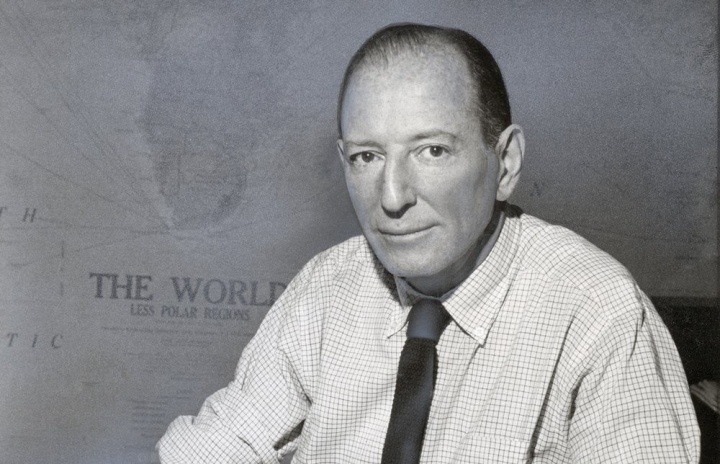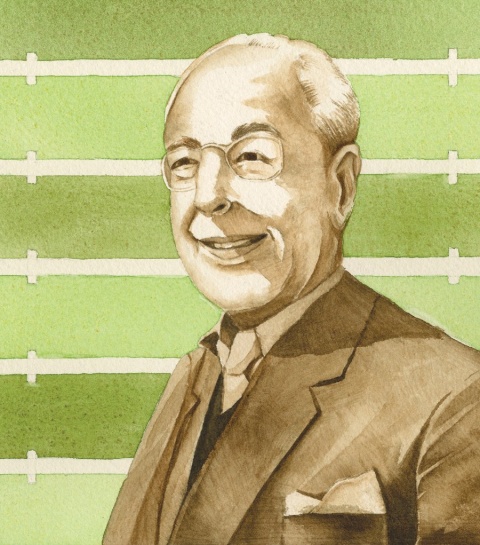Thanks to CCT and Thomas Vinciguerra ’85, JRN’86, GSAS’90 for the nice retrospective on the life and work of Theodore M. Bernstein CC 1924, JRN 1925.
Columbia College | Columbia University in the City of New York
Thanks to CCT and Thomas Vinciguerra ’85, JRN’86, GSAS’90 for the nice retrospective on the life and work of Theodore M. Bernstein CC 1924, JRN 1925.

Tom Lippman ’61
Washington, D.C.
Regarding Thomas Vinciguerra ’85, JRN’86, GSAS’90’s excellent article on Theodore M. Bernstein CC 1924, JRN 1925 in the Spring 2019 issue: My SAE fraternity brother Bill Smith ’57, who went to work at The New York Times, used to send me copies of Bernstein’s Winners & Sinners newsletter. Bernstein picked out excellent work to praise, but he was also the defender of the proper use of language and the paper’s resident grammar teacher.
I upbraided young Arthur Ochs Sulzberger Jr. at a conference some years ago about the Times’s failure to uphold those standards, pointing out that I’d counted nearly a dozen errors in the paper just that morning. He said, “We have bigger fish to fry.” Perhaps, but I believe that as the self-proclaimed “newspaper of record,” the Times should have a responsibility to be a paragon of excellence in the practice of its craft as well. Alas, that seems just another sign of decline in the once-great “Gray Lady.”
Robert Lauterborn ’56
Chapel Hill, N.C.
Sentimental. Inspired. Motivated. All words that describe my feelings as I read Matt Reuter ’07’s “The Last Word,” in the Spring 2019 issue.
I too was a proud member of Columbia’s men’s club lacrosse team during my student days, 1989–1993. Those teams were a diverse collection of men from a variety of Columbia schools. In addition to highly competitive lacrosse, the team provided us with great conversation, camaraderie and fun. And while an outside observer may have described us as a ragtag operation, we were passionate about the sport, and about Columbia.
Those passions endure — and perhaps burn hotter — today, as lacrosse alumni ponder the same question now as we did then: How could Columbia, which is located at the virtual epicenter of lacrosse in America (most club players hail from the tri-state area), be the only Ivy school without a men’s varsity team?
Since the 1990s, lacrosse has continued to grow and thrive in America, and especially in the Ivy League. In just that time, the league has boasted an amazing seven national champions, 10 finalists and many, many qualifiers.
Put simply, the Ivy League may well be the nation’s strongest lacrosse league — with Columbia embarrassingly watching from the stands, year in and year out.
Today, I am proud to be part of a dedicated, organized group of alumni that is working to promote lacrosse at our fine institution and to ensure that the true “last word” is a men’s varsity team at Columbia.
Matt DeFilippis ’93
Bayville, N.Y.
Thank you so much for Matt Reuter ’07’s essay in “The Last Word,” Spring 2019. Reading his narrative helped me relive the excitement I felt playing for the men’s lacrosse team 1992–96. I clearly remember walking from Carman to South Field with my lacrosse stick after seeing Eric Drath GS’94 throwing the ball around with a couple of his frat brothers (and his dog). I committed to the team that day and spent the next four years playing the game I love with a group of guys that continue to be some of my closest friends.
Special thanks to Matt for his research about the team and for leading a group of alums passionate about promoting men’s lacrosse at Columbia. I love the fact that Columbia will host the Ivy League tournament again! I will be there, but as I sit in the stands my thoughts will wander to a future where our team competes in a complete Ivy League tournament — #makeit8.
Uchenna Acholonu Jr. ’96
New Hyde Park, N.Y.
What a joy to read “They Called Him ‘Mr. Little’” by Alex Sachare ’71 in the Spring 2019 issue (“Roar, Lion, Roar”), particularly that whopping victory over Army in 1947. Now that I have reached the plateau of the 90s, memories fill the void of eyesight. That game was the big one for all of us, and especially for me. My uncle was a West Point graduate. The cadets were overjoyed when their score totaled 20. Out came their clean, square white handkerchiefs — the West Point visitors stands, waving us off. Undaunted, the Lion started to roar. Our secret weapon was our feet, pounding Baker Field’s old wooden stands. Right after Bill Swiacki ’49 made his amazing touchdown catch … slowly but surely, out came a sea of multicolored and rumpled handkerchiefs signaling “bye-bye, Army.” Never sang “Oh, Who Owns New York?” as lustily. The corps surely heard that, clean up the Hudson to the Point.
Durand Harootunian ’50
Ridgewood, N.J.

Mary Kate Connors
Alex Sachare 71’s otherwise commendable profile in the Spring 2019 issue of Coach Lou Little fell short by just one extra point: Coach Little’s near-defection to Yale in 1947–48.
Just months after Columbia’s miraculous 21–20 victory over Army at Baker Field on October 25, 1947, Yale football coach Howie Odell resigned to become coach at the University of Washington. Mindful of Little’s coaching genius, the Yalies tried luring Little to New Haven with a tempting offer to become not only head football coach, but also athletics director, for bigger bucks.
Little was torn. In early 1948, during a Columbia-Penn basketball game he was attending, Little told The New York Times that “it was a terribly difficult decision I had to make to choose between two of the finest schools in the country.”
As Yale’s president, Charles Seymour, began applying pressure on Little to depart Columbia after 18 years as head coach, Columbia’s defensive team rose to the occasion. Ultimately, the job fell to Gen. Dwight D. Eisenhower, then Columbia’s president-designate.
Eisenhower, in his memoir At Ease: Stories to Tell Friends, recounted the meeting with Little: “While I was still Chief of Staff [of the Army], and on the eve of my departure to take up my duties at Columbia, I was given the mission of saving Lou for the University. He had been offered the head coaching job at Yale. Columbia alumni panicked. They decided that only I could persuade Lou to stay on. A group of them, headed by Bill Donovan [CC 1905, LAW 1908], of the OSS in World War II, and Frank Hogan [CC 1924, LAW 1928], the New York District Attorney, escorted Lou to Fort Myer for a talk. I had no professional or financial arguments to offer. I was reduced to a personal appeal. It was not at all eloquent.
“‘Lou, you cannot do this to me,’ I said. ‘You’re one of the reasons I am going
to Columbia.’
“The coach seemed a little flustered. But he recovered quickly and, asking for time to consider the future, we talked football, reminisced, and had a general discussion on the state of the game. For once all the years I spent coaching seemed to make sense. I continued to be uneasy about Lou’s decision. And then I learned that immediately on his arrival to his hotel in Washington, he called his wife, Loretta, and said, ‘Stop packing. We’re not going [to Yale].’”
And thus did Eisenhower recall his encounter with the man who would go on to become, in Sachare’s words, “the winningest coach in Columbia football history.”
Bob Orkand ’58
Huntsville, Texas

Published three times a year by Columbia College for alumni, students, faculty, parents and friends.
Columbia Alumni Center
622 W. 113th St., MC 4530, 6th Fl.
New York, NY 10025
212-851-7852
cct@columbia.edu

Columbia Alumni Center
622 W. 113th St., MC 4530, 4th Fl.
New York, NY 10025
212-851-7488
ccalumni@columbia.edu